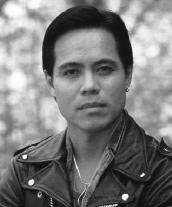THE BUSINESS OF FANCYDANCING
written and directed by Sherman Alexie with Evan Adams, Michelle St. John, Gene Tagaban, and Swil Kanim runs May 10-16 at Varsity
HOW MUCH fancydancing do you have to do if your roots and friends are back on the res but your reputation and celebrity as a gay Native American poet-spokesman are worldwide?
Keep dancing as fast as you can, like Seattle-based Seymour Polatkin (the marvelous Evan Adams of Smoke Signals), who wants less than anything to go home again—yet writes only about his Spokane Indian reservation and its people. Seymour’s at the divided heart of The Business of Fancydancing, Sherman Alexie’s vivid, insightful, ruminative directorial debut (loosely adapted from his 1992 collection of stories and poems of the same name).
Seymour’s status as an absentee icon prompts his embittered oldest friend, Ari (Gene Tagaban), to call him “a little public relations warrior,” while his other res buddy, fiddle-playing Mouse (Swil Kanim), complains that Seymour has plundered his eccentric stories and no-less-eccentric life for fiction.
Fancydancing opens in flashback as Mouse’s video camera catches Ari and Seymour, co-high-school valedictorians, goofing off before they leave home for college in mid-’80s Seattle. There, Ari slowly founders in an unfamiliar world, then retreats sourly to the reservation. Meanwhile, Seymour makes the leap successfully and even begins a four-year-long college relationship with a half-Jewish/half-Spokane Indian woman, Agnes Roth (Michelle St. John), in spite of his growing knowledge that he’s gay.
More than a decade later, a jangling 3 a.m. call from Agnes, now a res teacher, summons Seymour home for Mouse’s funeral. Although pills killed him, a sampling of Mouse’s tastes—denatured alcohol cocktails, a sandwich of bathroom cleaner sprayed on white bread—gives clues to the pathologies of the reservation. Watching Ari huff gasoline fumes suggests he’s not far behind.
The painful present and idyllic past blend evocatively together at Mouse’s wake, held in a handsome old frame house. At this somber reunion, Alexie has Ari and Seymour debate a conflict he must know firsthand: an artist’s sources versus his obligations.
Full of great, naturally-occurring music and strong performances, Fancydancing mixes handheld cameras, poetic intertitles, and beautifully shot interludes of costumed tribal fancydancing. Less successful is a grating, unnamed interrogator, a walking theatrical device whose blunt questions to Seymour mirror the writer’s torn conscience.
Yet whatever the conflicts inherent to creating art, Fancydancing is also a textbook argument for the artist’s final authority. In his production notes, Alexie explains how a stringent budget and cheap digital video let him keep “all creative and financial control,” allowing him to add 17 minutes of reshooting and re-editing since early-’02 Sundance and Taos festival screenings. I’ve seen both versions, and these 17 minutes have made Fancydancing deeper, clearer, and stronger in nearly every detail. Every filmmaker should have such options— and talent.
Sherman Alexie will introduce the shows at 4:40, 7, and 9:15 p.m. on Fri. May 10.








